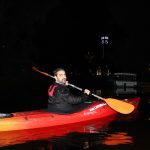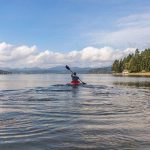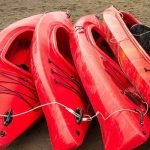Whether you are a beginner or an experienced kayaker, it is always a good idea to have a kayaking trip checklist. This is especially important if you are planning a trip to a remote destination.
Your kayaking trip checklist should be tailored to your individual preferences and the conditions of your trip.
We’ve compiled a kayak trip checklist with a variety of items that you may need for your next trip. Use our list as a guide to help you determine what kayaking equipment is necessary.
If you’re new to kayaking, here’s a list of essential equipment you should get. Some of these items may not be required, but they can improve your overall experience.
For a full guide and list of kayaking gear, read on or jump to the section you need!
What to Bring on a Kayak Trip
What equipment do you need to get started kayaking? Most of these items are essential for every kayaker, especially when you’re just starting out. This list of beginner kayaking equipment includes the basics that you should always have with you when you go out on the water.
Kayak
In order to kayak, you will of course need a kayak. However, not just any kayak will do. The best type of kayak for a beginner is a short and simple recreational kayak.
These kayaks are easy to get in and out of because of their large cockpits. In addition, they usually have back support and a foot pedal to help with steering when the water is choppy.
A sit-on-top kayak doesn’t have a cockpit and might be a good choice if you’re worried about being trapped in a kayak. One downside is that you could get wet from water dripping off the paddle.
There are a few different types of kayaks, each with different features. You should be able to find one that suits your needs.
To learn more about your options and compare them, check out this kayak buying guide.
Buoyancy Aid
Buoyancy aids are similar to life jackets but allow more movement in the neck and arms. This is ideal for kayaking as you need to move your arms a lot while paddling.
Even strong swimmers should wear a buoyancy aid as water can be unpredictable and dangerous.
Always keep your buoyancy aid on while you’re on the water. Put your buoyancy aid on while you’re on shore before you enter your kayak to make sure it’s working properly.
A buoyancy aid will help keep you safe and relaxed so you can enjoy your outing more.
Paddle
You will need a paddle when you go kayaking. Be careful not to buy a canoe paddle by mistake. Kayak paddles have blades at both ends and are usually between 82 and 102 inches long.
The taller you are, the longer your paddle will be.
If you are going on a long kayaking trip, you should take an extra paddle with you in case you break or lose your paddle.
Wetsuit/Dry Top
What you wear on a kayaking trip will likely depend on the weather conditions. If it’s hot and sunny, you might want to opt for a T-shirt and shorts, particularly if you’ll be kayaking on calm water.
On a cold day, you may want to wear a wetsuit or drysuit for insulation. A wetsuit is tight-fitting and made of neoprene which keeps your body temperature in cold water.
They’re commonly used for scuba diving, but could also be beneficial
if you take a plunge while kayaking. A drysuit is a watertight suit that allows you to wear normal clothes beneath it and is made of waterproof materials. T
hese tend to be more expensive than wetsuits, but the choice ultimately boils down to your preferences. You may also want to consider wearing kayaking gloves.
Kayakers often wear a kayaking cagoule or dry top to stay dry. However, you should be aware that you will likely get wet and the air might be warm but the water could be cold.
If you fall into the water, it’s best to be prepared by wearing clothes that will keep you warm.
The best type of clothing to wear kayaking is something that you can move around in easily, that dries quickly, and provides sun protection.
If you’re just getting started, you don’t need to go out and buy specialised gear – any clothes you have at home will do to start with. Here are a few of my favourite pieces of kayaking clothing and accessories.
- Supportive swimsuit or a sports bra (avoid swimsuits that will pull on your neck)
- Carve Designs Rashguard
- Quick-drying Patagonia Women’s Board Shorts (Patagonia makes these in a men’s version as well)
- Sandals or Water Shoes
- A Sun hat
- Polarized Sunglasses w/ a retainer so you don’t lose them in the water
- If it’s chilly or windy it can be helpful to have a lightweight rain jacket or windbreaker.
Wet Shoes
If you’re planning on going kayaking, you’ll want to make sure you’re wearing shoes that can get wet.
Wet shoes have rubber soles that provide good traction and support, which can be essential on slippery surfaces. flip-flops are generally not a good idea, since they don’t offer much support and can be easily blown off your feet.
You can wear other types of shoes, like sneakers, but they can get uncomfortable quickly if they get wet.
It’s a good idea to invest in wet shoes, especially if you’re planning on going on a long kayak trip. They don’t cost too much, and they can save you a lot of discomfort.
Rope Bag
There is a rope inside this bag, so that you can rescue another kayaker if needed. You would hold one end of the rope while you throw the bag towards the kayaker who needs help.
If you are paddling without a group or an instructor, you should bring a rope bag with you.
Dry Bag
A dry bag is a watertight bag you can use to store things you want to keep dry, like your cell phone, a set of dry clothes, or snacks. Most dry bags come with a clip and a roll-top to keep your belongings secure.
Others
. There are a few other things that I like to bring with me when I kayak besides the essentials.
- Sunscreen
- Lip Balm with SPF
- A reusable water bottle
- Paddling gloves – If you’re paddling for a long distance, a pair of paddling gloves can help prevent blisters
- Snacks
- Camera – A GoPro is an awesome choice for kayaking because it’s waterproof, great for POV shots, and can easily mount to different spots on your kayak.
- Durable Dry Bag – 10 liters is good for a day trip and is necessary for keeping your stuff, like your phone, dry
- Carabiner – you can use this to clip your dry bag or water bottle to your kayak.
- Garmin Mini – if you are out of cell reach, I always advocate for bringing this emergency communication device.
Considerations for your First Kayaking Excursion
When you are planning your first kayaking trip, there are a few considerations you’ll want to make:
- Trip Length: For your first-time kayaking, plan a trip that is less than three hours. You don’t want to exhaust yourself or bite off more than you’re ready for.
Three hours gives you enough to get a feel for kayaking and decide if you like it. - Wind/Water Conditions: If it’s windy, you might opt for another day. Wind poses an additional challenge that sometimes is unavoidable, but we recommend trying kayaking for the first time when it’s calm out.
Also, lake, calm river, or bay conditions tend to be easier than the ocean for new paddlers. - Take a class or go on a guided tour: If you’re nervous, consider taking a class or joining a guided tour for your first trip. Use REI’s Class Finder to see if there is one near you.
You’ll build a foundation, familiarity with the gear, and the confidence to go on your own next time. Or who knows? Maybe you’ll meet a new paddling partner in the class.
Managing Common Kayaking Fears
As an ocean kayaking guide for the Channel Islands, BFT community member, Kim, knows that many people are afraid of kayaking. She has heard all of the fears people have.
Some people are afraid of falling out of the kayak. Others are afraid of being swept out to see. If you have these fears, Kim has some tips to help you.
What If I Fall In?
If you happen to flip your kayak over, don’t worry. It’s difficult to flip a kayak over, and it’s even more difficult to flip a tandem kayak. However, you should know how to get yourself back in the boat, just in case.
If you want to kayak, Kim says that you should practice falling in so that you know how to get back into the kayak if you fall out. You should also wear a personal flotation device at all times.
If you’re working with a company that rents out kayaks, listen to their safety talk and ask any questions you may have before you start kayaking.
I’m Afraid That I Might Not Be Fit Enough
Kayaking is usually better in the morning than in the afternoon, as winds can pick up in the afternoon, making kayaking more difficult. For the first half of your trip, try to head into the wind. That way, when you’re tired later on, you can kayak downwind and get a little boost.
Should I Worry About Sharks If I’m Kayaking in the Ocean?
Since Kim leads tours in the Channel Islands, she often gets asked about the likelihood of seeing sharks. Although it is rare to see sharks, many people are afraid of them.
If you are on a tour led by Kim or renting from a business, it is okay to ask if they have frequent experience with sharks or if this is something you should be aware of.
How to Transport a Kayak
This is a difficult task for first-time kayakers. You need to transport the kayak from the store to the water. We recommend renting a kayak from a location on the water so you don’t have to deal with this.
If you have to load the kayak onto your car, this video will give you step-by-step instructions. This is a inexpensive way to secure the kayak to your roof without a special rack.
Inflatable kayaks are a good option for flatwater paddling if you don’t want to deal with the hassle of attaching a kayak to your roof.
- Inflatable Sit-Inside Kayak: This Aquaglide Deschutes Inflatable Kayak packs down into a bag for a very reasonable price.
Simply unpack it at your launch point, hook it up to an air pump (not included), and you’re ready to go. If you’re looking for a two-person option, check out this Advanced Elements Tandem Inflatable Kayak. - Inflatable Sit-On-Top Kayak: We’ve seen some inflatable sit-on-top kayaks out there, and some are even made to double as stand-up paddleboards.
You can check out a few inflatable sit-on-top kayaks here.
- ORU Foldable Kayak: A few years ago, I took an ORU Foldable Kayak with me to New Zealand and Canada.
This packs down into a “box” and can be put together in about 10 minutes once you get the hang of it. Here is a time-lapse video I made that shows you how the ORU Kayak works.
How to Sit in a Kayak
Body Posture
Sit with a straight back in the kayak, with your legs bent and out in front of you. Your knees should be placed against the side of the kayak for stability and power in your strokes.
Most kayaks have a backrest that can be adjusted to make you more comfortable.
Foot Position in a Kayak
There should be a pair of footpegs at the front of your kayak near your feet. Your legs should be bent and your knees should be touching the side of the kayak. If your legs are fully extended or bent too close to your body, adjust the footpegs as needed.



